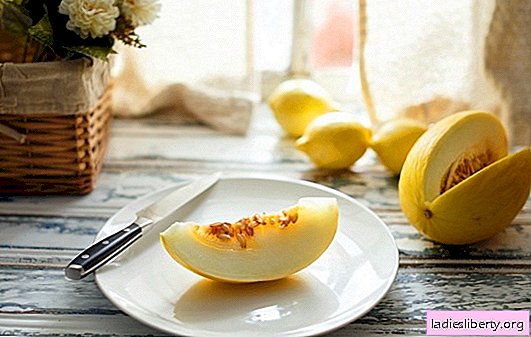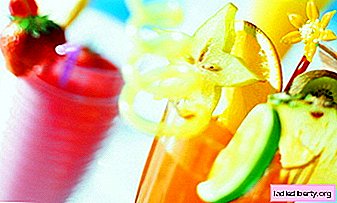
The beginning of August is precisely the period that lovers are waiting for to enjoy delicious melons. Naturally, you can "take a sample" of melons from the new season in July, but they will not be the same melons.
The best varieties that we love so much - the collective farmer and the torpedo, will appear in August. However, the chance to run into a completely tasteless melon is very high even at the height of the season. Let's try to figure out how to choose a sweet melon, including everyone’s favorite torpedo?
How to choose a sweet melon: useful and harmful properties
Fragrant sweet melon is a gift of nature. We love this vegetable not only for its pleasant taste and aroma, but also for many healthy dietary properties. For example, with its help it is possible to improve the functioning of the gastrointestinal tract, increase immunity, relieve apathy and depression, and also improve the condition of the skin.
Many probably heard about the popular melon diet, which will help you quickly and productively get rid of extra pounds without feeling painful hunger attacks.
It's no secret that this vegetable has a lot of useful properties, as well as some disadvantages. For example, this fruit is completely It is not recommended to use for people who suffer from diabetes and ulcers.
Besides, its use is undesirable for nursing motherssince the child may have unpleasant difficulties and indigestion in the future.
Also, after you have eaten a melon, it is not recommended to consume cold water, sour milk, yogurt or kefir - this can cause indigestion.
The same problems may occur in a person who decides to combine the use of a sweet vegetable with alcohol.
Fruits with damage (cracks) can melt the onset of diseases such as botulism and salmonellosis.
How to choose a sweet melon?
Naturally, a gentle taste and many useful properties awaits each lover to taste fresh melon. But, unfortunately, not everyone knows how to choose it correctly. There are certain recommendations that will help you make the right choice.
1. The color and condition of the peel. For these varieties, the light yellow color of the peel in a fine mesh is characteristic. However, the cobweb should also be a yellowish tint. If this is not so, and the shade of green is clearly visible in the fruits - the fruit has not yet clearly ripened, and it is best to simply skip it. Pay attention to the number of longitudinal grooves on the fruit, the higher their number - the vegetable will be more tender and sweeter. Make sure that the surface of the melon is not full of any damage, like spots or cracks. The emergence of the former suggests that the fetus is already beginning to gradually become unusable, the latter is a clear sign of overriding, and various viruses, dust and dirt can enter the pulp through them.
2. Density. A good, high-quality melon fruit should be fairly dense and firm. If you, touching it, drew attention to excessive softness - it is better to refuse a melon, since it is overripe and is already starting to fade slightly. Also, you do not need to choose too hard fruits - such vegetables may still not be fully ripened.
3. The aroma. If a pleasant smell emanates from the fruit you have chosen, you will probably feel it right there. When choosing a melon, many may simply be embarrassed to smell it - and in vain, it is a pleasant aroma that will help you determine a really sweet copy.
4. The condition of the tail. If the melon fruit ripened under the right conditions and was picked in a timely manner, its tail will probably be dry. If you choose a fruit, but notice that it has a greenish tail, or if it is missing at all, it is better to skip it and pick another one, this one has simply not fully ripened.
5. We look at the "nose". On the side opposite from the tail, there is another excellent sign of the quality of the fetus - its “nose”. Do not apply a little pressure on the “nose” of the fruit, if it is too hard - the melon fruit remains not fully ripe, the soft one indicates that the melon is completely ready for use.
6. Pulp. A high-quality melon fruit has a white, juicy and dense pulp. Naturally, it will not be possible to make an assessment of this characteristic for obvious reasons (we hope you do not need to be reminded that the purchase of cut melons is strictly prohibited?).
7. Acquisition time. No matter how anxious you are to buy a delicious melon early, it is better to wait with this purchase until mid-August, especially if you are a big fan of the Torpedo variety. Otherwise, instead of a delicious fruit, you may be "lucky" to get on a fruit stuffed with a large amount of nitrates, which is unlikely to pass without a trace for you.
How to identify a fetus with nitrates?
Separately, I would like to give some advice on the determination of melon fruits with a large number of nitrates. Fruit, acquired in June or July - a priori will be nitrate, however, buying a melon in September does not protect you from the "chemistry" inside.
Of course, it is simply not possible to identify externally, without any special devices at hand, a vegetable stuffed with nitrates to the eyeballs. However, if you saw well-traced longitudinal veins - this is a clear sign of the presence of nitrates inside. Such a fruit will have almost no smell, the seeds will be empty, with a grayish tint. In addition, in the "unclean" fruit, the place of attachment of the tail will vary somewhat in color with the rest of the fruit. Remember, the concentration of nitrates in the center will always be lower than near the skin.
And finally: even if you are well aware of how to select a quality fruit, this does not give you complete confidence. The fact is that you can buy fruit not far from highways or land that does not have the necessary documentation and is simply not intended for growing these vegetables. Melons themselves are not easy food for the stomach, and the presence of additional heavy metals and carcinogens is unlikely to benefit him.
How to choose a sweet melon Torpedo, what is the difference between this variety
One of the best and most popular varieties in our area is considered a torpedo melon. This variety comes from Uzbekistan, has an oblong shape and a characteristic light yellow color. The name of the variety was accordingly due to its shape, outwardly similar to a combat torpedo.
Like any kind of melon, a “torpedo” should be chosen primarily on the basis of a dry tail, a stable, pleasant smell and a soft “nose”. If we are talking specifically about the taste characteristics of this variety, it should be noted that, first of all, it should have an elongated shape, yellow color, a fine mesh and bright yellow longitudinal stripes. Moreover, the latter should not be solid, but scattered along the vegetable, as if by a dashed line.
Also note that the seeds in a ripe melon should leave the pulp without problems, and specifically in the “Torpedo” they should have a mucous membrane.











